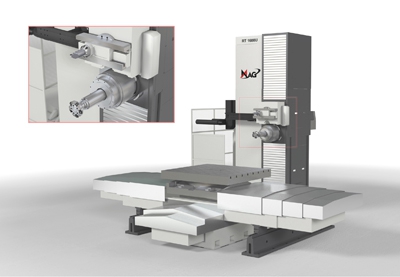
MAG combines the reach and power of its boring spindles with a newly developed integrated contouring head, introduced for its horizontal boring mills in 1,250mm and 1,600mm (49.1 and 63 inch) table/pallet sizes and live-spindle HMCs in 800mm to 1,600mm (31.5 to 63 inch) pallet size.
The new contouring head has a standard tool interface, which greatly reduces tooling costs, and it loads tools via the machine's automatic toolchanger for faster processing without operator involvement. The contouring spindle's U-axis slide stroke provides the ability to produce small- or large-diameter features without head changing or manual intervention, allowing complex features to be machined in one setup with greatly reduced cycle time and labor. The contouring head can produce features such as bottle bores, valve seats, seal faces, phonographic sealing surfaces, O-ring grooves, straight/tapered threads, chamfers, external profiles and others. It is ideal for single-setup, rough and finish machining of oil and gas parts or any large part that combines bored, milled and turned features.
The integrated contouring head will be available with a standard Kennametal KM80 or Sandvik Coromant Capto C8 tool interface. In addition, the live boring spindle can use 50-taper tools as long as 750mm (29.5 in), and an auto-coupler provides the interface for use of feedout tools, such as programmable boring bars.
According to Pete Beyer, MAG Director, Product Strategy and Product Development: "The contouring head is engineered as a drop-in module that can be added during manufacture or later, as well as removed for service without affecting operation of the boring spindle. A simple shifting mechanism allows it to be powered by the main spindle motor, reducing complexity and cost. In addition to providing greater slide stroke than other machines or add-on contouring heads, our design includes a slide counterbalance to offset centrifugal force, ensuring optimum part roundness and accuracy. Overall, the integrated contouring head is a great advance over current boring mill technology, which would require two auxiliary heads to produce the same diameter range; a head changing system and storage rack; manual tool changes; and proprietary tools to provide the same functionality. We are reducing mechanical complexity, floor space, cycle time, tooling costs, and labor, while improving part quality."
The contouring spindle for both boring mills and HMCs is located immediately above the machine's main spindle, but slightly offset in the Y and W/Z axes to avoid tool interference. Rated power will be 56 kW/75 hp (S6-40 percent) on boring mills, and 45 kW/60 hp (S6-40 percent) on HMCs. A touch probe can be used in the boring spindle or on an auxiliary arm for in-process or post-process measurement of part features machined by the contouring spindle. Standard services, such as coolant supply, are plumbed through the contouring head to eliminate manual intervention and ensure maximum tool life.
Contact Details
Related Glossary Terms
- automatic toolchanger
automatic toolchanger
Mechanism typically included in a machining center that, on the appropriate command, removes one cutting tool from the spindle nose and replaces it with another. The changer restores the used tool to the magazine and selects and withdraws the next desired tool from the storage magazine. The changer is controlled by a set of prerecorded/predetermined instructions associated with the part(s) to be produced.
- boring
boring
Enlarging a hole that already has been drilled or cored. Generally, it is an operation of truing the previously drilled hole with a single-point, lathe-type tool. Boring is essentially internal turning, in that usually a single-point cutting tool forms the internal shape. Some tools are available with two cutting edges to balance cutting forces.
- coolant
coolant
Fluid that reduces temperature buildup at the tool/workpiece interface during machining. Normally takes the form of a liquid such as soluble or chemical mixtures (semisynthetic, synthetic) but can be pressurized air or other gas. Because of water’s ability to absorb great quantities of heat, it is widely used as a coolant and vehicle for various cutting compounds, with the water-to-compound ratio varying with the machining task. See cutting fluid; semisynthetic cutting fluid; soluble-oil cutting fluid; synthetic cutting fluid.
- milling machine ( mill)
milling machine ( mill)
Runs endmills and arbor-mounted milling cutters. Features include a head with a spindle that drives the cutters; a column, knee and table that provide motion in the three Cartesian axes; and a base that supports the components and houses the cutting-fluid pump and reservoir. The work is mounted on the table and fed into the rotating cutter or endmill to accomplish the milling steps; vertical milling machines also feed endmills into the work by means of a spindle-mounted quill. Models range from small manual machines to big bed-type and duplex mills. All take one of three basic forms: vertical, horizontal or convertible horizontal/vertical. Vertical machines may be knee-type (the table is mounted on a knee that can be elevated) or bed-type (the table is securely supported and only moves horizontally). In general, horizontal machines are bigger and more powerful, while vertical machines are lighter but more versatile and easier to set up and operate.
- toolchanger
toolchanger
Carriage or drum attached to a machining center that holds tools until needed; when a tool is needed, the toolchanger inserts the tool into the machine spindle. See automatic toolchanger.






